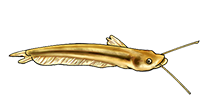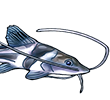Unidentified doradidae being brought in by Jeff Rapps/TUIC
- Koltsix
- Posts: 45
- Joined: 25 Feb 2007, 01:49
- My images: 5
- My cats species list: 44 (i:10, k:10)
- My Wishlist: 3
- Spotted: 35
- Location 1: Bronx, New York
- Location 2: United States
- Interests: Fishkeeping- Currently into Auchenipteridae/ Trachycorystes, Dorididae/Centrodoras and Cichlidae/ Crenicichla. I also enjoy Photography, Writing, Reading and Cars.
Unidentified doradidae being brought in by Jeff Rapps/TUIC
Jeff Rapps of Tangled Up In Cichlids was nice enough to share with me some pics of a potential Doradidae cat he maybe getting in whose i.d. remains in question(he knows I'm a Dora fiend  ). The pics where taken in two locations, two pics in the market where dead specimens where being sold as food and one pic of juveniles in the suppliers holding tank. Both Jeff and I agree that the head is very similar to Pterodoras Granulosus but I also feel the head is reminiscent of Centrodoras Brachiatus but that's where the similarities end for us. The Dora has a dorsal surface that isn't mottled like a Pterodoras but is instead spotted and in that way similar to Irwini/Uranoscopas ventral pattern. How ever unlike Irwini/Urano it has no pattern at all on the ventral surface of the fish. Also the ventral surface is colored a bright orange in the adult dead specimens being sold at the market and in the living juvenile specimens is a bright yellow. The coloration, head and body shape lead us to wonder what species these cats are. Is it some regional color variation of Granulosus?? Or something else entirely?? As such I'm throwing myself at the feet of people far more knowledgeable then myself and am asking you guys for help. Anyone have any guesses as to the i.d. of these cats? And how interested would you be in owning one? I myself know I'm chomping at the bit hoping Jeff gets these guys in so I can scoop them up and see them upclose and personal. Here's the pics Jeff shared with me.
). The pics where taken in two locations, two pics in the market where dead specimens where being sold as food and one pic of juveniles in the suppliers holding tank. Both Jeff and I agree that the head is very similar to Pterodoras Granulosus but I also feel the head is reminiscent of Centrodoras Brachiatus but that's where the similarities end for us. The Dora has a dorsal surface that isn't mottled like a Pterodoras but is instead spotted and in that way similar to Irwini/Uranoscopas ventral pattern. How ever unlike Irwini/Urano it has no pattern at all on the ventral surface of the fish. Also the ventral surface is colored a bright orange in the adult dead specimens being sold at the market and in the living juvenile specimens is a bright yellow. The coloration, head and body shape lead us to wonder what species these cats are. Is it some regional color variation of Granulosus?? Or something else entirely?? As such I'm throwing myself at the feet of people far more knowledgeable then myself and am asking you guys for help. Anyone have any guesses as to the i.d. of these cats? And how interested would you be in owning one? I myself know I'm chomping at the bit hoping Jeff gets these guys in so I can scoop them up and see them upclose and personal. Here's the pics Jeff shared with me.



-
Viktor Jarikov
- Posts: 5571
- Joined: 26 Jan 2010, 20:11
- My images: 11
- My cats species list: 25 (i:0, k:0)
- Spotted: 4
- Location 1: Naples, FL
- Location 2: USA
Re: Unidentified doradidae being brought in by Jeff Rapps/TU
Looks like a Pterodoras to me. I think granulosus or, since less than half of SA fishes have been described to date, an undescribed Pterodoras may be possible. I cannot discount Pterodoras rivasi http://www.planetcatfish.com/common/spe ... ies_id=871
I hope others than me who know what they are talking about chime in...
I hope others than me who know what they are talking about chime in...
Thebiggerthebetter
fish-story.com
fish-story.com
- Silurus
- Posts: 12453
- Joined: 31 Dec 2002, 11:35
- I've donated: $12.00!
- My articles: 55
- My images: 896
- My catfish: 1
- My cats species list: 90 (i:1, k:0)
- Spotted: 428
- Location 1: Singapore
- Location 2: Moderator Emeritus
Re: Unidentified doradidae being brought in by Jeff Rapps/TU
Some of the Cat-eLog images of show a spotted fish. I don't see any significant differences.

- Koltsix
- Posts: 45
- Joined: 25 Feb 2007, 01:49
- My images: 5
- My cats species list: 44 (i:10, k:10)
- My Wishlist: 3
- Spotted: 35
- Location 1: Bronx, New York
- Location 2: United States
- Interests: Fishkeeping- Currently into Auchenipteridae/ Trachycorystes, Dorididae/Centrodoras and Cichlidae/ Crenicichla. I also enjoy Photography, Writing, Reading and Cars.
Re: Unidentified doradidae being brought in by Jeff Rapps/TU
Thank for the suggestion, it's much appreciated and it's one worth taking into consideration considering according to the supplier/collector these guys max out at around 20 inches.Viktor Jarikov wrote:Looks like a Pterodoras to me. I think granulosus or, since less than half of SA fishes have been described to date, an undescribed Pterodoras may be possible. I cannot discount Pterodoras rivasi http://www.planetcatfish.com/common/spe ... ies_id=871
I hope others than me who know what they are talking about chime in...
Thanks for the response, it's much appreciated. The most significant difference I thought was the yellow belly coloration as I said in my above post. The coloration exists in both living and deceased specimens and I've never seen any fish in the catalog that has such coloration except for preserved specimens where I would think the preservation process probably affected the coloration of the fish. To me such a bright ventral area is a significant color difference.Silurus wrote:Some of the Cat-eLog images of show a spotted fish. I don't see any significant differences.
Though I see where your coming from suggesting it's merely Granulosus. As it was suggested in a thread I created on MFK that perhaps this is a regional color variant of Granulosus? So they would tend to agree with you. It is possible, but according to the supplier these guys go by a different common name then Granulosus when being sold in the market and that these guys max out at around 20 inches while he states Granulosus is a much larger fish. Though I will admit the collector is no scientist, still maybe if he and the locales and think this isn't Granulosus there maybe some credence. But then again I'll state perhaps this is just wishful thinking on my part.





